FAQs (Q & A) about Hindu Texts (Hinduism / Sanatana Dharma) (Part 1 of Part 3)
Namaste friends, how are you doing today? Welcome to #BhagavanBhakthi website / blog.
Bhagavan Lord Sri Krishna (Vishnu, Rama, Dattatreya, Narasimha, Kapila, Trivikrama) and Goddess Rukmini (Lakshmi, Sita, Anagha, Dharini) blessings to you and your family!
In this website / blog, you will always learn about #Hinduism #Sanskrit language.
Also subscribe to my YouTube channel from this link #BhagavanBhakthi to view videos about #Hinduism #Sanskrit language.
Just before going to “FAQs (Q & A) about Hindu Texts (Hinduism / Sanatana Dharma) (Part 1 of Part 3)“, let us know a brief, basic and very important information.
Let us take one question at a time and understand the correct answer for each question:
What are the FAQs (Q & A) about Hindu Texts (Hinduism / Sanatana Dharma) (Part 1 of Part 3) is as given below:
1. Who these 3 are?
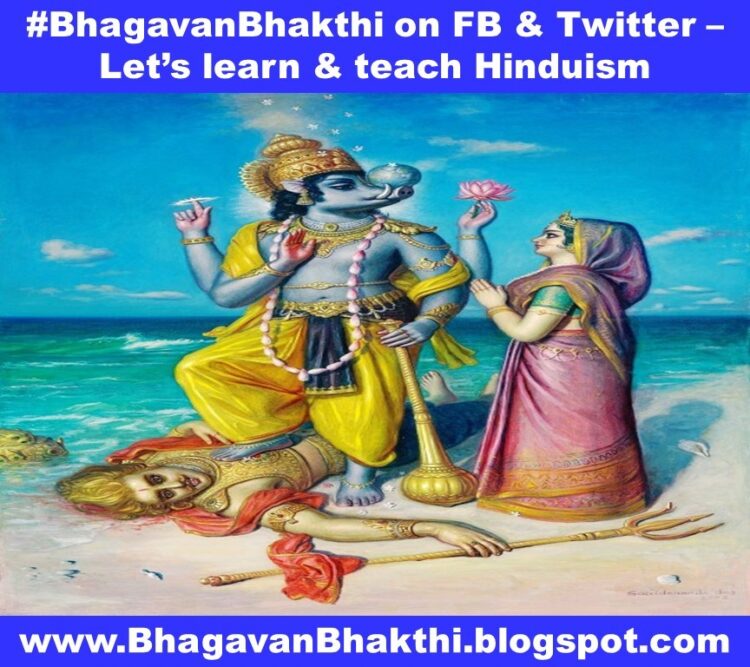
Answer: Bhagavan Sri Varaha Swamy (Bhagavan Sri Vishnu’s avatar) along with his consort Sri Bhudevi (mother earth) and the demon Hiranyaksha.
2. Who are these three? (marked in white arrow marks)
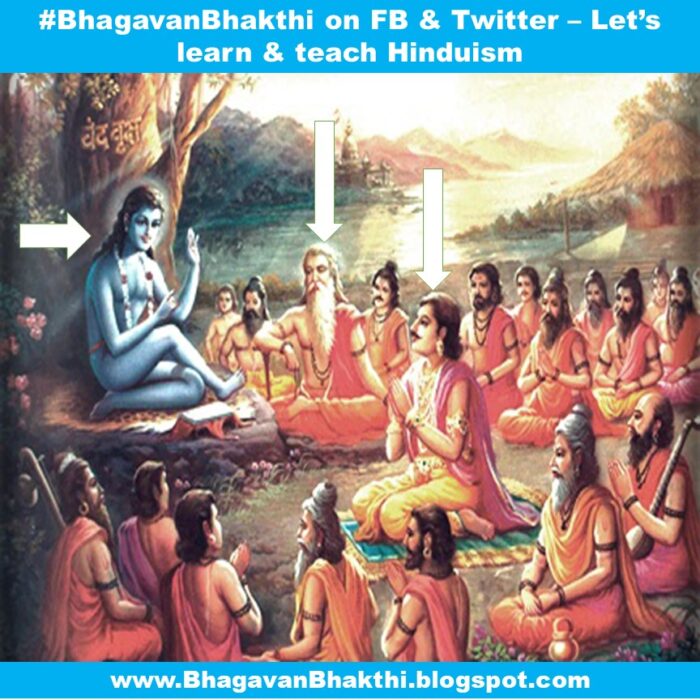
Answer is: From Left: a. Shukacharya Ji (son of Sri Veda Vyasa Ji). He is the avatar of Lord Shiva. b. Sri Veda Vyasa Ji. He is avatar of Bhagavan Sri Vishnu. c. Parikshita Maharaja. He is the son of Abhimanyu & Uttara Kumari Devi and grand son of Arjuna & Subhadra Devi.
This is the situation when Parikshita had been cursed by a Brahmana Shamika’s son Shringi (young boy), that Parikshita Maharaja will dead in next 7 days by snake bite.
During this time, svayam (directly) Shukacharya Ji (an avatar of Lord Shiva) comes and starts preaching the Bhagavatam to Parikshita Maharaja.
To this full story, click the below link:
Who cursed King Parikshit – Takshak snake, Sage Shamik, Shringi story
3. What is the correct meaning of the name “Govinda”?
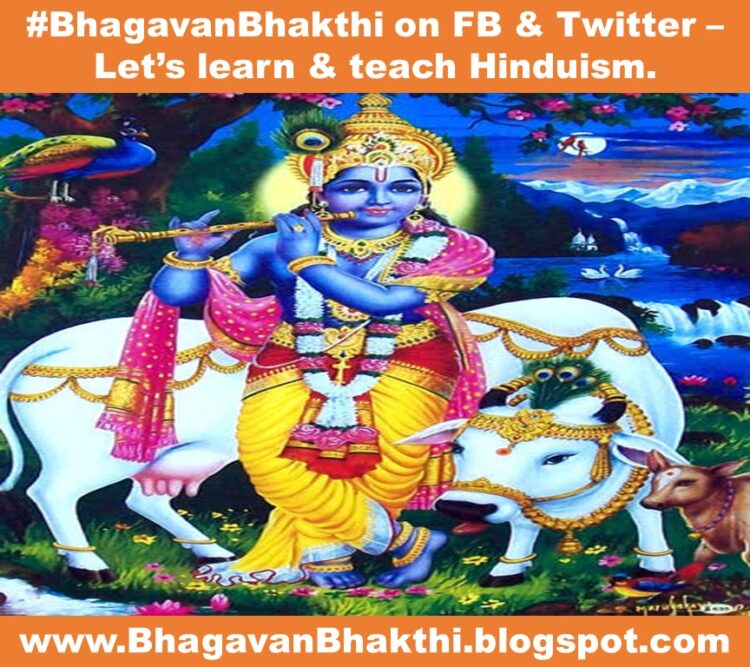
Answer: Govinda = Gov + in + da = Cow + Indriyas + controller (& protecter) and winner. He is someone who has control over the cows and all the indriyas. Also, he is the one who protects and safeguards the Go-maata (mother cow).
Lord Sri Krishna is not at all dependent on anything or anyone. He is called as ‘sarvasvatantra‘, means he is completely independent. Similarly all others are completely dependent on him starting from Sri Mahalakshmi Devi, Sri Brahma Deva, Sri Rudra Deva etc.
Also, Lord Krishna is called as ‘aatma kaama‘, means he can’t be satisfied by the external material or spiritual things. He is satisfied within himself. But a bhakta / devotee can worship him with just a leaf, flower, fruit and definitely Sri Krishna will be happy and satisfied with his / her devotee.
4. Who is this person with goat head and what is the situation about?
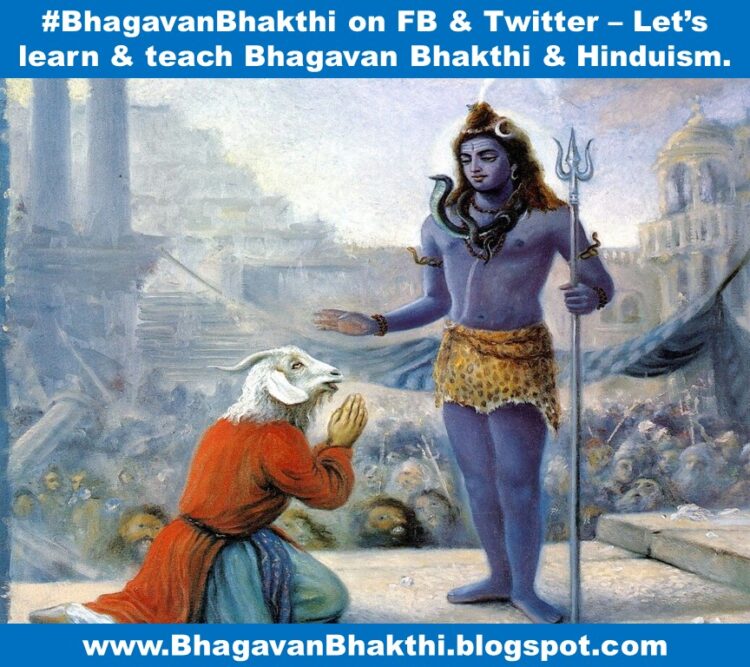
Answer: He is Daksha Prajapati. He is the father of Sati Devi & father-in-law of Lord Shiva. Because of his ignorance and arrogance, he had humiliated Lord Shiva earlier. Because of this he got the goat’s head. Later the kindhearted Lord Shiva blessed him.
5. Many of us know that Amba was reborn as Shikhandi and was the cause for the death of Bhishma. But how many can answer earlier to Amba, what she was and what was the relationship with Bhishma with her?
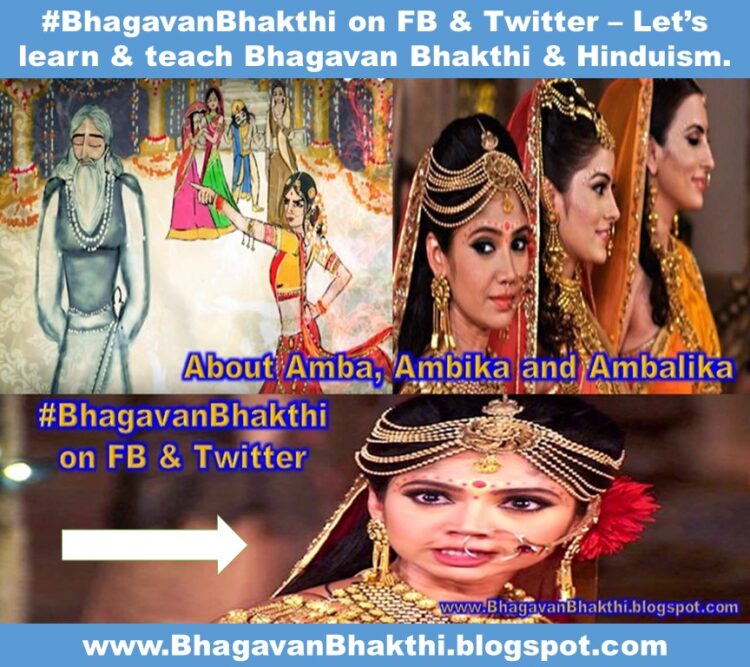
Answer: In the 28th Dvapara Yuga (the Yuga when Bhagavan Sri Krishna was born), ‘Ashta Vasus’ took birth on earth as sons of the Goddess Ganga Devi and Kuru Kingdom Raja Shantanu due to a curse from Maharshi Vasishtta.
Among eight, seven of them got liberated from this mortal world as soon as they took birth, whereas the eighth one by name Dyau / Dyu (Prabhasa) had to endure a longer life.
This Vasu named Dyau / Dyu was none other than the great warrior of Mahabharata fame Bhishma (Devavrata). This Dyau / Dyu wife was Vargi and she was none other then this Amba / Shikhadi.
To know more about this, you can click this link:
Ashta Vasus names, significances
6. What is the correct meaning of the Bhagavan ‘Rama’ name?
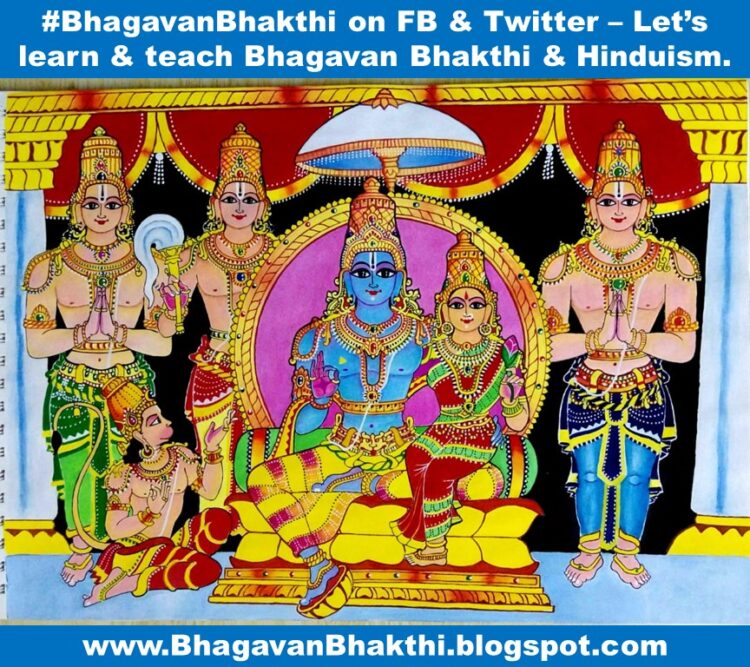
Answer: I have written a post on this. Please click the below link to know the answer for this:
7. How many of you can tell the meaning of the name ‘Sudhama’?
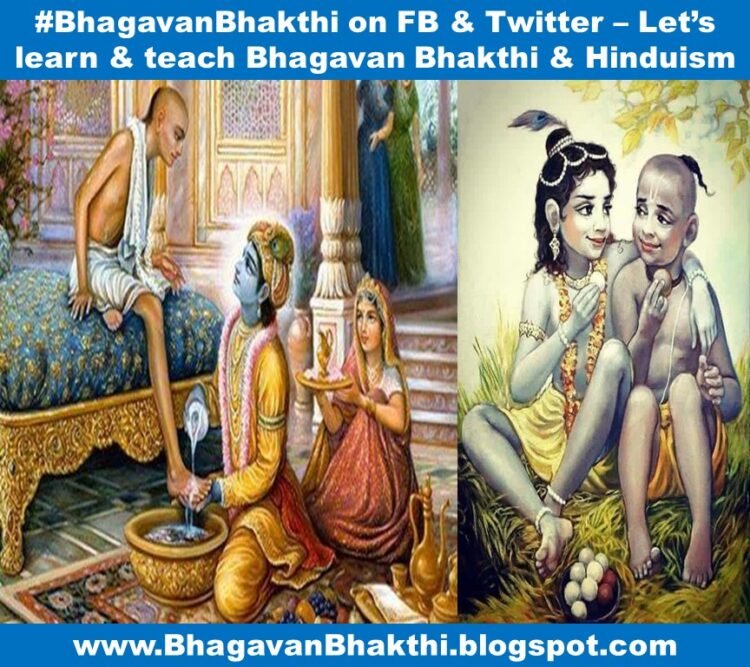
Answer: Let us know the inner meaning of the name ‘Sudhama’. Here su + dhama – ‘su’ means the Sarvottama (Supreme) Bhagavan Vishnu and ‘dhama’ means living in ‘Vaikuntta’.
Bhagavan Vishnu is so great, that he not only lives in Vaikuntta, but also lives within his devotees. E.g., Within Sudhama Brahmana.
8. Lava or Kusha – Who is elder and how?
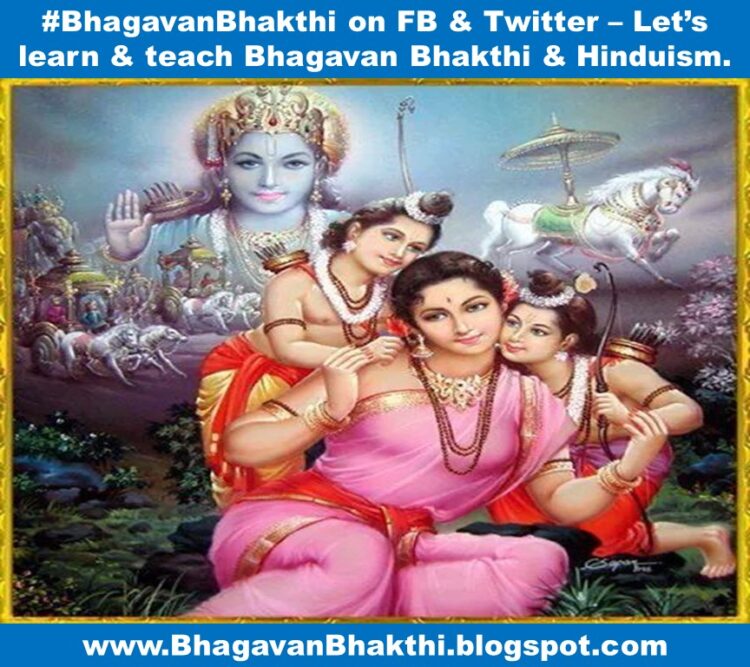
Answer: Yes, as many of you have said, Kusha is the elder son of Bhagavan Sri Rama and Sita Devi. But how? Actually, it was Lava who was born first, but still how come Kusha is elder? Ramayana says that, the first baby who entered into the womb of Sita Devi was Kusha and then later it was Lava.
Thus, since Kusha entered the womb first, it is Kusha to be called as elder and not Lava. Others should also follow the same pattern, that it, the baby who born second is the elder one among the twins.
9. What are the names of the four sons of Dasharatha and what is the chronological order in which Dasharatha’s sons were born as per Ramayana? I Know this looks like very easy question, but there is a clarification to be given here, as the TV serials have not given the correct knowledge about this.
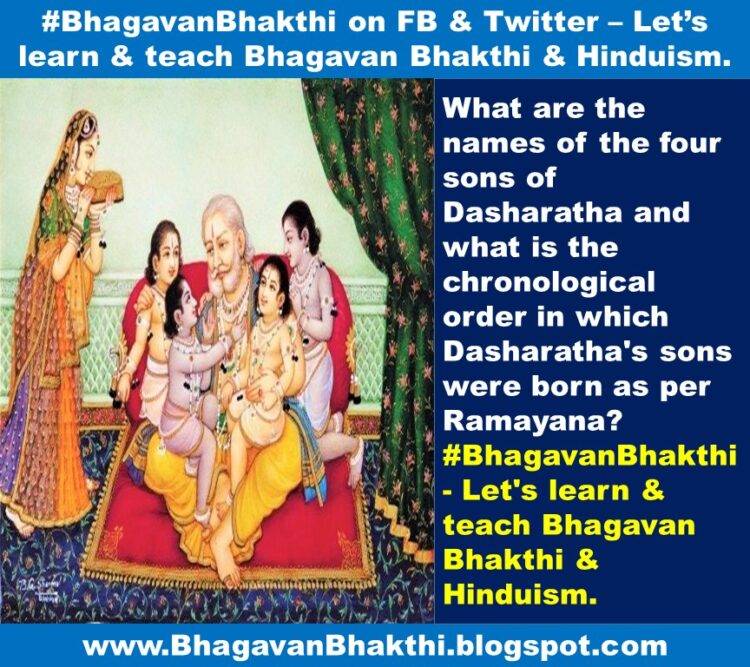
Answer: Dasharatha’s four sons were Bhagavan Sri Rama, Lakshmana, Bharata and Shatrugna (Shtrughan). This is also the right chronological sequence of the births of these four brother.
Also note that, Lakshmana and Shatrugna were not twin brothers as shown on TV serials. Rather Lakshmana was two year older than Shatrugna.
As said above first it was Bhagavan Sri Rama, then after one year Lakshmana was born, then again after one year Bharata was born and finally later after one year Shatrugna was born. One each year gap was there in between each of the brothers.
10. Why Draupadi married 5 men?
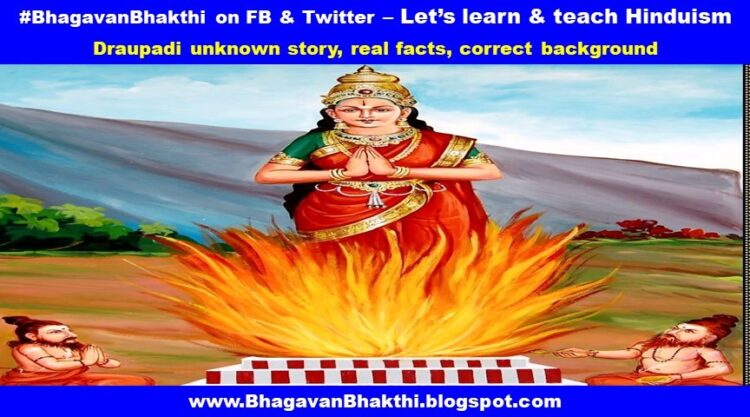
If we understand the inner meaning and secret of the Mahabharata, we can know that, Draupadi Devi is not just one woman. She is the amalgamation of 5 divine Devis, that is, Sri Bharati Devi, Sri Parvati Devi, Sri Sachi Devi, Sri Shyamala Devi and Sri Usha.
For more information, you can visit this link:
There are few people who always will be waiting to talk something negative about Hindu Sanatana Dharma. Especially in the case of the ‘mahan patirvrata Draupadi Devi’, few people are always negative.
These people have to change their way of thinking immediately, otherwise they will definitely have to face great problems in their lives.
11. Who these 3 are and what is this situation about?
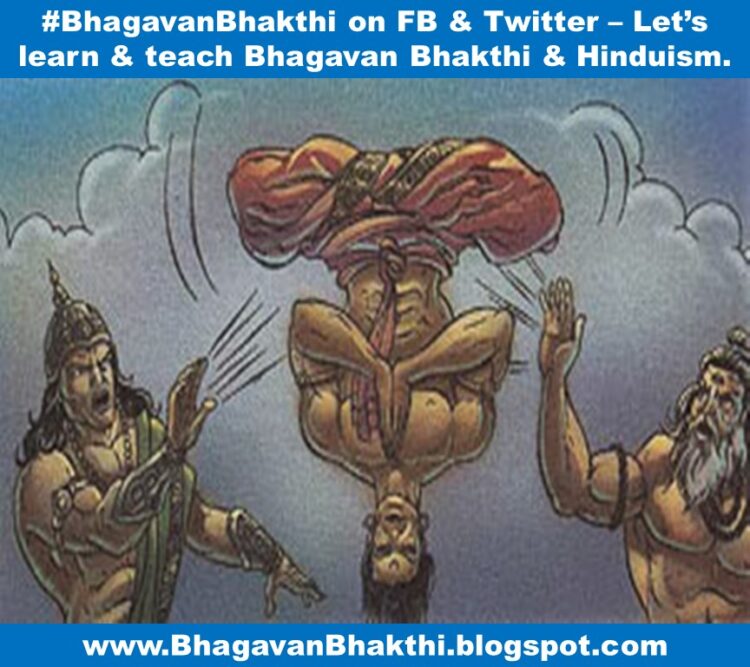
Answer: From left: a. Indra Deva, b. Trishanku (Satyavrata), c. Maharshi Vishwamitra.
This is the situation, when Satyavrata (Trishanku) tries to enter the Svarga Loka with his material body and Indra Deva doesn’t allows this. As Maharshi Vishwamitra was very close to Satyavrata, Maharshi Vishwamitra builds a new Svarga Loka for Satyavrata.
To know the full story of this, please click the below link: Trishanku Story
12. What are the names of the seven Saptarishis?

Answer: Names of Saptarishis are as given here: a. Kashyapa | b. Atri | c. Bharadwaja | d. Vishvamitra | e. Gautama | f. Jamadagni | g. Vashishtha |
To know more details of all these Saptarishi, you can visit this link: Saptarishi details correct information
13. What are the different avatars of Lord Sri Krishna’s parents Vasudeva & Devaki before this avatar?
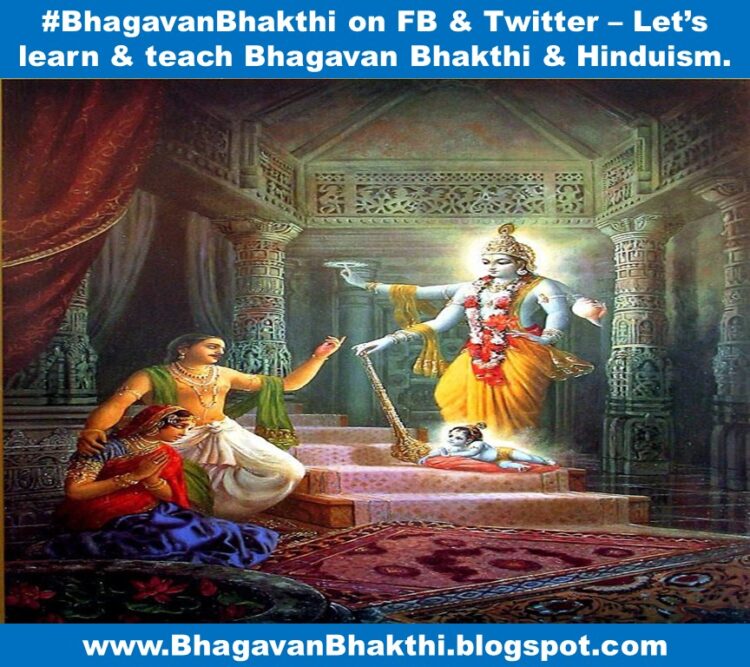
Answer: Vasudeva & Devaki have taken totally three avatars:
a. Sutapa & Prushni (Prsni) – For them Bhagavan Vishnu was born as ‘Prushnigarbha’ (Prsnigarbha). b. Kashyapa & Aditi – For them Bhagavan Vishnu was born as Vamana. c. Vasudeva & Devaki – For them Bhagavan Vishnu was born as Sri Krishna.
Totally Vasudeva & Devaki have taken three avatars as said above.
To know different avatars in Mahabharata, you can visit this link: Avatars in Mahabharata
To know different avatars in Ramayana, you can visit this link: Avatars in Ramayana
14. Who all are these and what is this situation about?
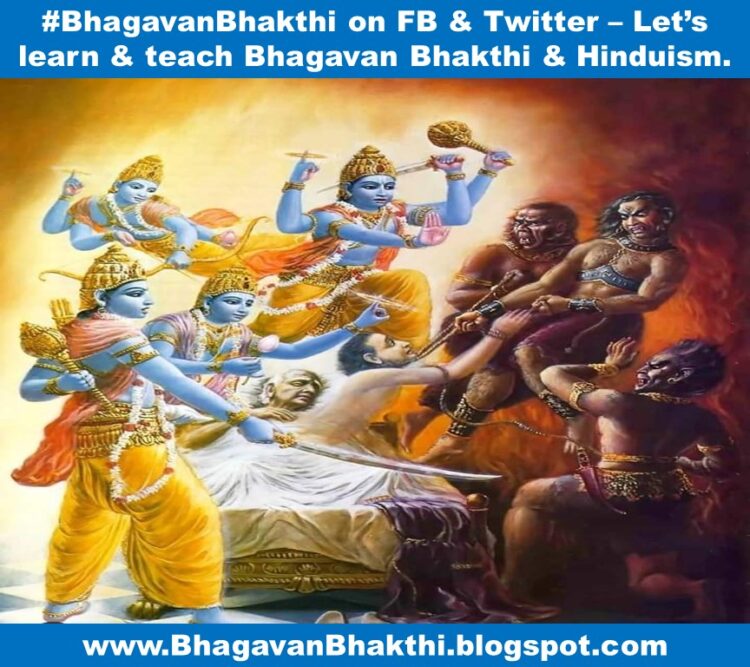
Answer: This is the story of Ajamila from Bhagavatam (Vishnu Purana). He used to be an atheist and was never believing in Bhagavan and had never done any Dharma Karma (works related to Dharma).
When he was around 80+ years, his end time arrives. At that time, Yama Dutas come and try to take away his life (aatma / soul) from his body. At that particular time, because of fear Ajamila loudly calls his youngest son named ‘Narayana’.
Since he uses Bhagavan Vishnu’s name ‘Narayana’ here, from Vaikuntha Bhagavan Vishnu’s Dutas immediately arrive there and stops the Yama Dutas from taking away his life. This is what happening in this image.
Left side are the Bhagavan Vishnu’s Dutas from Vaikuntha. Right side are the Yama Dutas and at middle, it is Ajamila. This is the greatness of chanting the names of Bhagavan Vishnu. If we even, unknowingly say or chant Bhagavan Vishnu’s name(s), Yama Dutas can’t come near to us.
This doesn’t mean we won’t die. We have to die one or the other day. But we will be spared of going to Yama Loka and other Narakas. Instead we will be able to go to higher planets.
[Many must have heard the saying ‘Ajagajantara’. Here ‘Aja’ means, Ajamila and ‘Gaja’ means Gaja (Elephant) from the Gajendra moksha story (fighting between Gajendra / Elephant & graha / makara / crocodile). Antara = difference]
Moral: In Ajamila story we came to know that Ajamila calls his son named ‘Narayana’ (Bhagavan Vishnu’s name) unknowingly. Whereas Gaja (Elephant) calls Bhagavan Vishnu by surrendering completely unto him.
This is the difference. Whether we call (chant) Bhagavan Vishnu, he will definitely come or send someone to help his devotees.
Come on friends, let’s all chanting Bhagavan Vishnu’s names: || Om Namo Narayanaya || Hare Krishna Hare Krishna, Krishna Krishna Hare Hare | Hare Rama Hare Rama, Rama Rama Hare Hare ||
15. Who these two are and what is the background story?
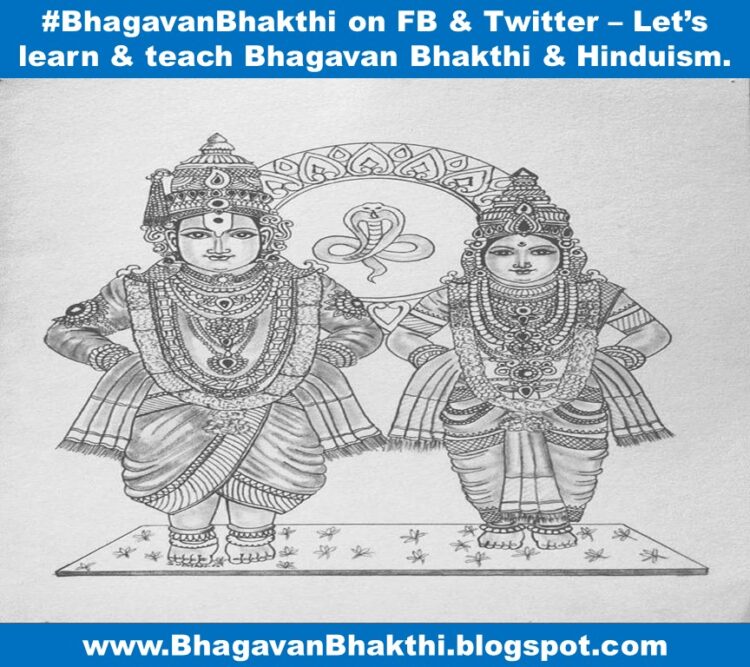
Answer: They are Bhagavan Vittala (Panduranga / Krishna) and Rukmini Devi (Sri MahaLakshmi Devi). Vittala = Vi + ttala = Vishwa (multiverses / unlimited universes) + present. Vittala is someone who is present in everyone and in everything in the unlimited universes.
Also Vittala means, Vittala = Vit (brick) + tala (stala / place). This means, someone whose standing place is a brick.
PanduRanga = Pandu + Ranga. Pandu = Color of the sky just before the rain starts (also means ash white color). Ranga = colored. This means, he is someone who is ‘neelamegha varna’ (clouds’ color just before the rain).
Rukmini = Ruk + mini = golden bright color + having. This means, she is someone who is having golden bright color.
To know more information about how Vittala / Panduranga was placed on a brick and what is the background story of Pundalika (a devotee of Panduranga), you can visit this link:
What is the Pundalika and Lord Vittla correct story
16. What is the meaning of Bhagavan Vishnu names ‘Venkatesha’ and ‘Srinivasa’ (Bhagavan Balaji names)?
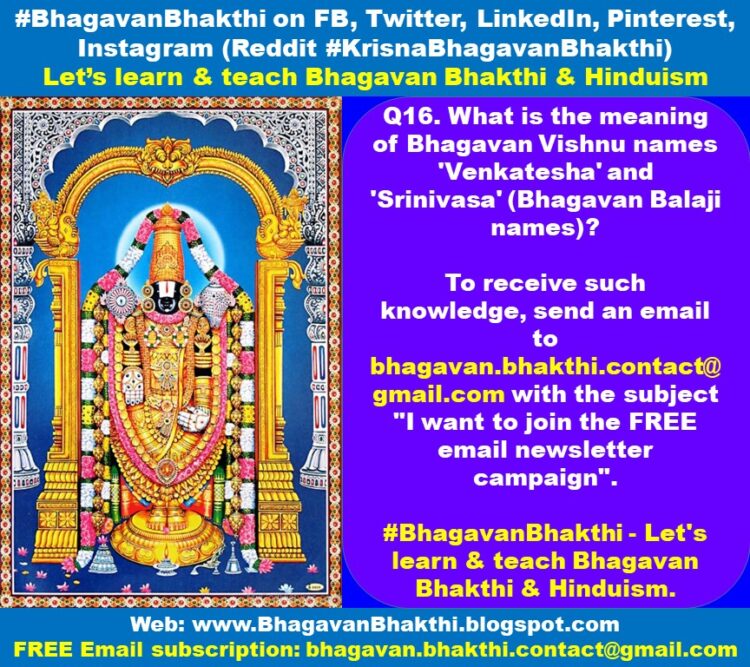
Answer: Venkatesha = Ven + Kata + Isha = Ego + remover (cuts off) + God. He is someone who removes (cuts off), our Ego. Srinivasa = Sri + ni + vasa = Lakshmi Devi + inside + living. He is someone who lives inside Sri Lakshmi Devi.
17. What are the meanings of the names ‘Saguna’ / ‘Gunaparipurna’ and ‘Nirguna’ of Bhagavan Vishnu?
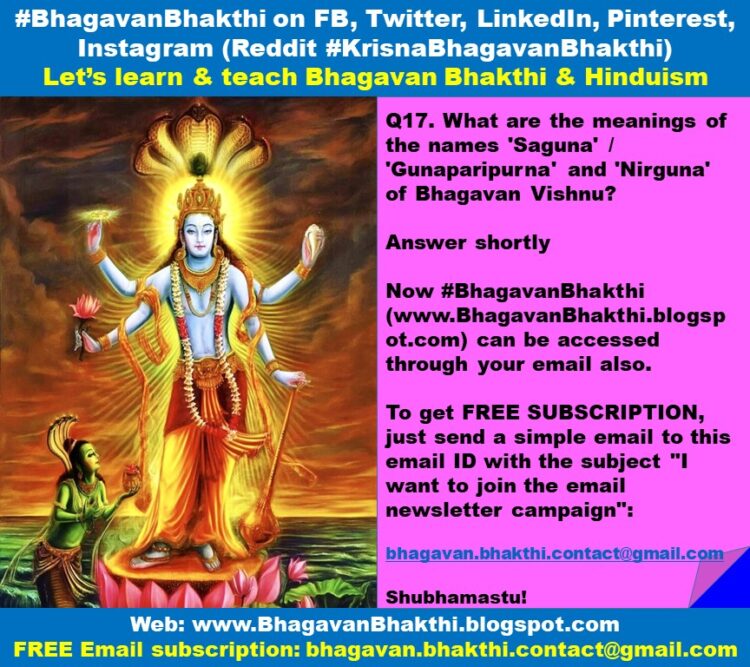
Answer: Bhagavan Vishnu has unlimited names and in that ‘Saguna’ / ‘Gunaparipurna’ and ‘Nirguna’ are those names which are been discussed by many since ages. Here people always misunderstand with these two names.
Here ‘Saguna’ or ‘Gunaparipurna’ means, someone who is full of Gunas (unlimited Gunas / qualities). Saguna = Sa + guna = With + unlimited qualities. He is always with infinite number of qualities.
Gunaparipurna = Guna + pari + purna = unlimited qualities + perfectly + filled. Bhagavan Vishnu is having so many qualities, that even Lakshmi Devi, Brahma Deva, Rudra Deva etc can’t understand.
Nirguna – This is the name which is always been discussed by many people, but people always tend to misunderstand this. As said above, if Bhagavan Vishnu is called as ‘Saguna’ or ‘Gunaparipurna’ means, then how can he be called as ‘Nirguna’.
Does Bhagavan Vishnu is having no Gunas (qualities) at all? If Bhagavan Vishnu is not having any qualities, then how can he be called as ‘Saguna’ or ‘Gunaparipurna’?
Let us understand that now: As per the correct understanding, Nirguna = Free of + Gunas. This means, Bhagavan Vishnu is completely detached from all Gunas (qualities). There is no Guna (quality) in this unlimited universes, which he is dependent like ordinary humans or other deities.
He doesn’t need any Guna (quality) which helps him to explain what he is. He is free of all the Gunas, that is, ‘Satva Guna’, Rajasa Guna’ and ‘Tamasa Guna’. He is free of all the Guna (qualities). He doesn’t depends on any Guna(s). He himself is ‘Saguna’ or ‘Gunaparipurna’.
Bhagavan Vishnu is full of qualities. But he is detached from all the qualities. Bhagavan Vishnu is not dependent on qualities, but instead qualities are dependent on Bhagavan Vishnu. This is the inner meaning of the names ‘Saguna’ or ‘Gunaparipurna’ and ‘Nirguna’.
18. Who are Bhagavan Vishnu’s children?
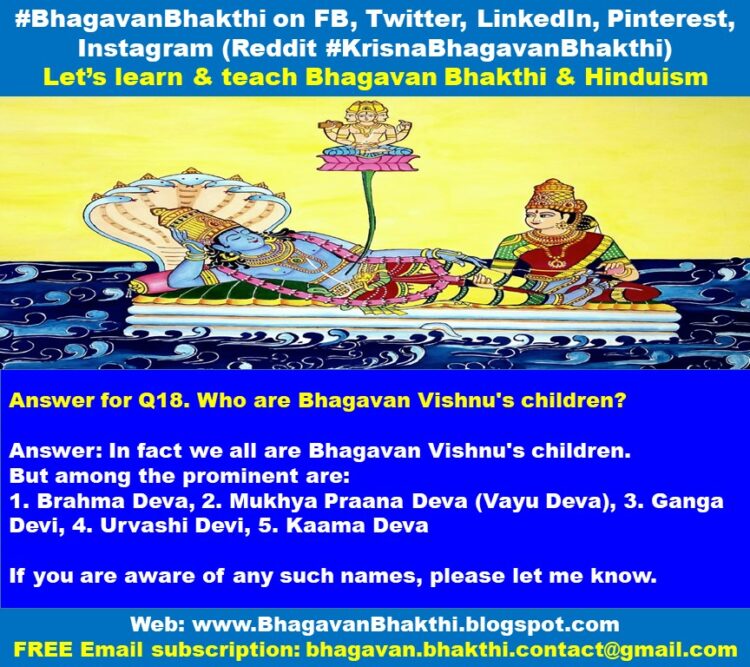
Answer: In fact we all are Bhagavan Sri Vishnu’s children.
But among the prominent are: a. Brahma Deva (From Bhagava Sri Vishnu’s nabhi / navel). b. Mukhya Praana Deva (Vayu Deva) (From Bhagava Sri Vishnu’s nabhi / navel). c. Ganga Devi (From Bhagavan Sri Vishnu’s lotus foot)
d. Urvashi Devi (From Bhagavan Sri Vishnu’s uru / thigh). e. Kaama Deva
If you are aware of any such names, please let me know.
19. Why Lord Vishnu took the avatar of Hayagriya Swamy?
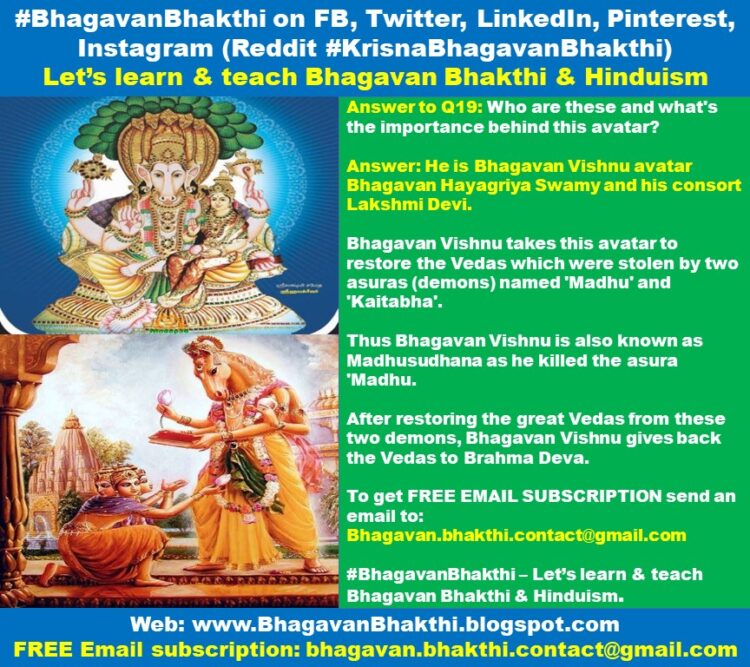
Answer: He is Bhagavan Vishnu avatar Bhagavan Hayagriya Swamy. Bhagavan Vishnu takes this avatar to restore the Vedas which were stolen by two asuras (demons) named ‘Madhu’ and ‘Kaitabha’. Thus Bhagavan Vishnu is also known as Madhusudhana as he killed the asura ‘Madhu.
After restoring the great Vedas from these two demons, Bhagavan Vishnu gives back the Vedas to Brahma Deva.
20. Who is the greatest devotee of Lord Vishnu?
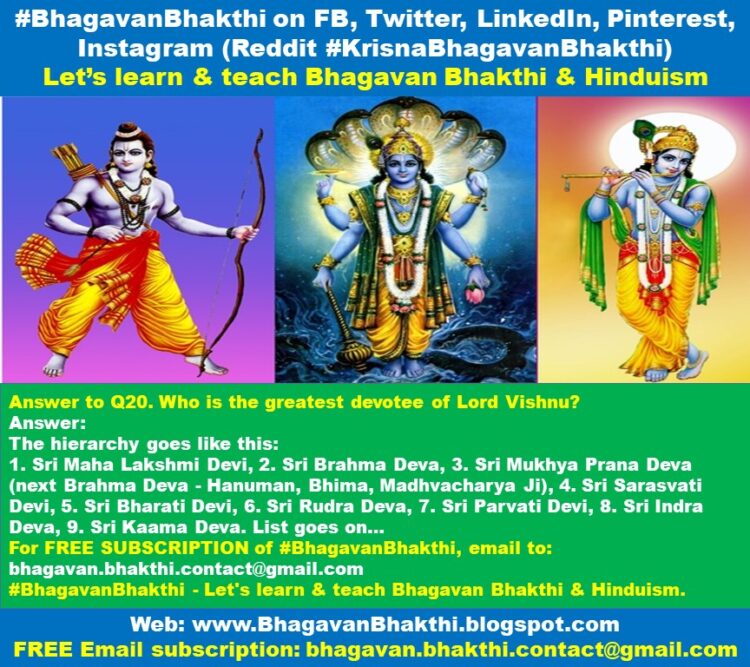
Answer: The hierarchy goes like this: a. Goddess Sri Maha Lakshmi Devi | b. Lord Sri Brahma Deva | c. Lord Sri Mukhya Prana Deva (next Brahma Deva – Hanuman, Bhima, Madhvacharya Ji) | d. Goddess Sri Sarasvati Devi |
e. Goddess Sri Bharati Devi | f. Lord Sri Rudra Deva (Shiva) | g. Goddess Sri Parvati Devi | h. Lord Sri Indra Deva | i. Lord Sri Kaama Deva | List goes on…
21. What is the meaning of the name ‘Shakuntala’?
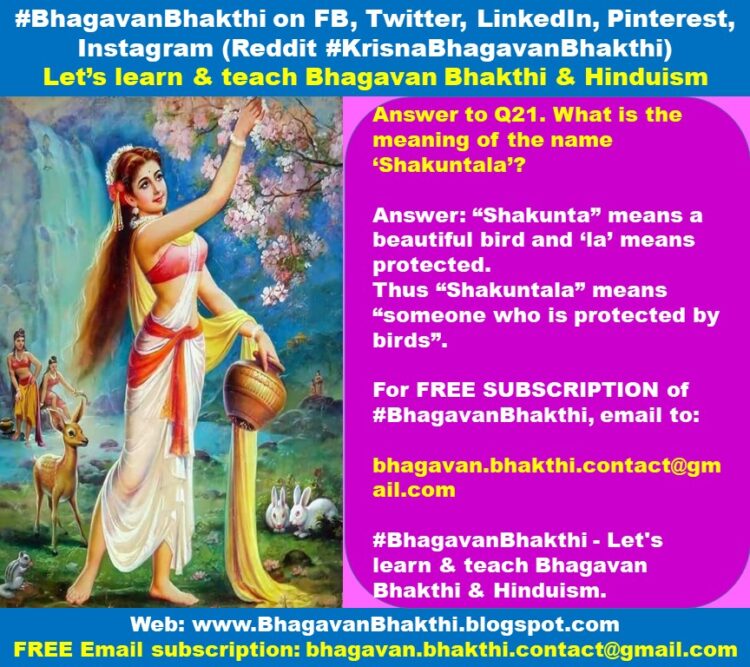
Answer: “Shakunta” means a beautiful bird and ‘la’ means protected. Thus “Shakuntala” means “someone who is protected by birds”.
To know the full story of “Dushyanta and Shakuntala”, you can visit this link: Dushyanta Shakuntala correct story
22. Who is Damodara and what it’s name meaning?
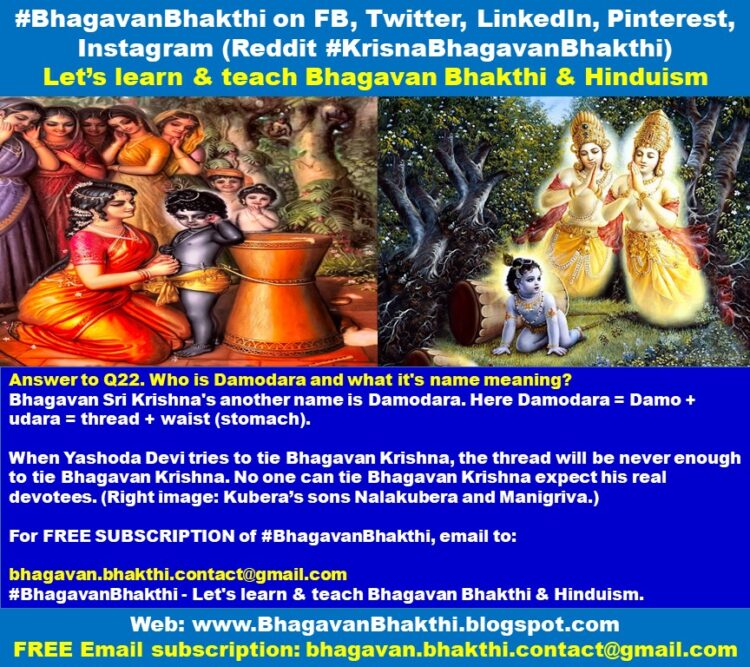
Answer: Bhagavan Sri Krishna’s another name is Damodara. Here Damodara = Damo + udara = thread + waist (stomach). When Yashoda Devi tries to tie Bhagavan Krishna, the thread will be never enough to tie Bhagavan Krishna.
No one can tie Bhagavan Krishna expect his real devotees. (Right image: Kubera’s sons Nalakubera and Manigriva.)
23. Who are Ashwini Kumaras?
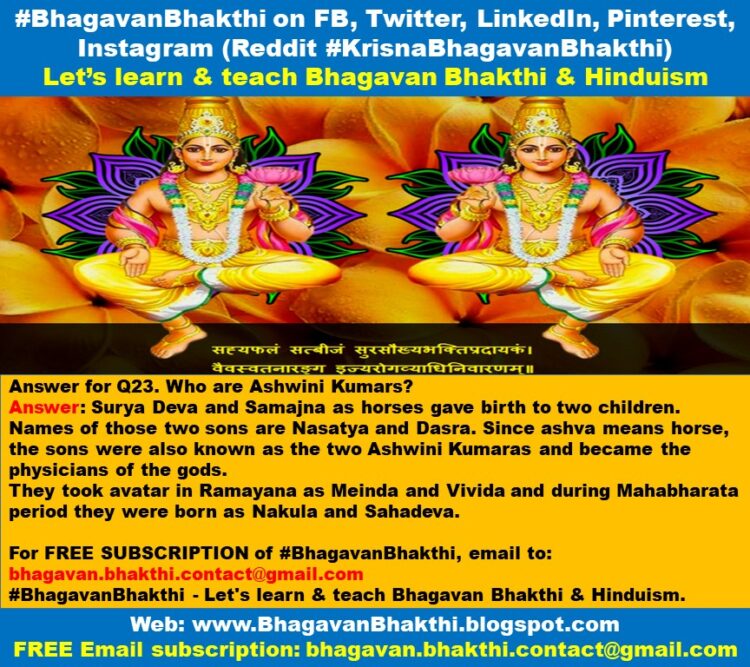
Answer: Surya Deva and his consort Samajna as horses gave birth to two children. Names of those two sons are Nasatya and Dasra. Since ashva means horse, the sons were also known as the two Ashwini Kumaras and became the physicians of the gods.
They took avatar in Ramayana as Meinda and Vivida and during Mahabharata period they were born as Nakula and Sahadeva.
24. How Lord Shiva became Chandrashekhar / Somashekhar?
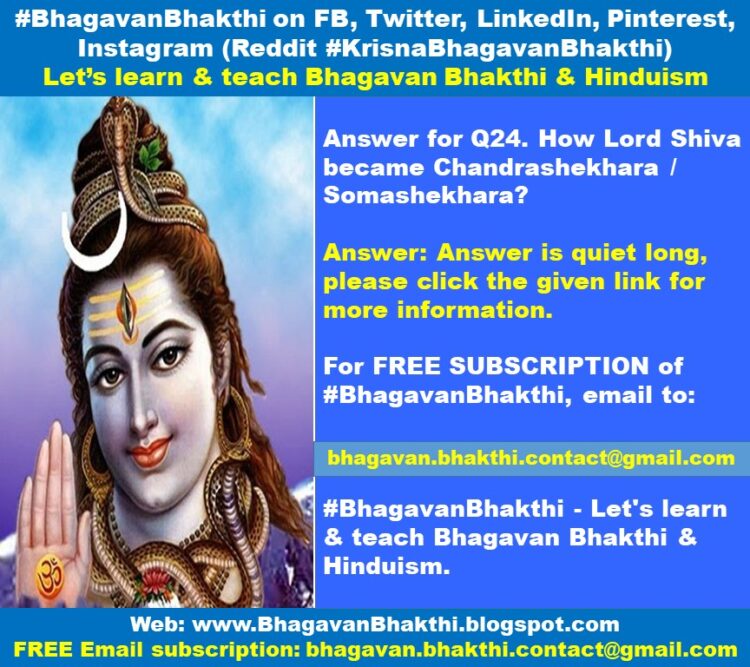
Answer: Answer is quiet long. I have written a separate post on this. Please click the below link to continue reading: How Lord Shiva became Chandrashekhar
25. Why Ganga is the most sacred river for Hindus / on earth?
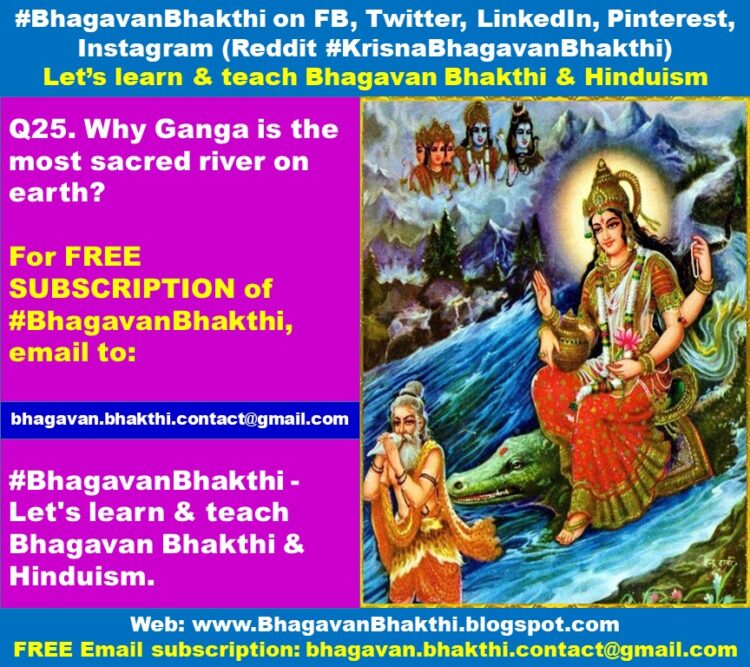
Answer: The main reason is that Ganga is the putri / daughter of svayam Sri Hari. She gets birth from the feet of Sri Hari. What punya would Ganga Devi had done to be born from the feet of Sri Hari. This is the most important reason that river Ganga is the most pavitra river on this earth.
The second most reason is that after river Ganga takes birth from the feet of Sri Hari, she goes and take rest in the kamandala of Sri Brahma Deva. This is the second reason for Ganga Devi being so sacred.
The third most reason is that after the above two, Ganga Devi goes and sits on the head of the Sri Rudra Deva / Sri Shiva.
Continue reading about Hindu Texts (Hinduism / Sanatana Dharma) part 2 of part 3 : FAQs (Q & A) about Hindu Texts (Hinduism / Sanatana Dharma) (Part 2 of Part 3)
Continue reading about Hindu Texts (Hinduism / Sanatana Dharma) part 3 of part 3 : FAQs (Q & A) about Hindu Texts (Hinduism / Sanatana Dharma) (Part 3 of Part 3)
To know “What is the greatness of Ganga, origin, history, names, festivals, birth, significance, reference” etc, you can visit the below link post: What is the greatness of Ganga, origin, history, names, festivals, birth, significance, reference
This has been continued in the next post because of the space constraints.
Click below link to move to Part 2 : What are the FAQs about Hinduism, Mahabharata, Ramayana – Part 2
If you are aware of any question(s), please let me. I will surely try to answer all of them.
Dear friends, if you need any clarifications about this post, kindly let me know, I will definitely try to answer all of them.
Also your one LIKE, one COMMENT, one SUBSCRIPTION is highly important.
This will help to know the quality of this content and also it will be helpful to know if any improvements is required for the content.
If you feel this content is useful to you and has helped you to improve your knowledge, kindly share this with your well-wishers.
Because “SHARING MEANS CARING”.
To receive FREE EMAIL SUBSCRIPTION about #BhagavanBhakthi, you can send an email to bhagavan.bhakthi.contact@gmail.com from your email ID.
NAMASTE!
Sri Gurubhyo Namaha
Sri Krishnaaya Namaha
Sri Krishnaarpanamastu
Share in Social Media